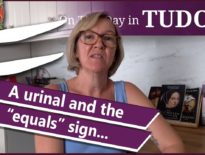On this day in Tudor history, 19th June 1573, Jesuit priest and former rector of a Lincolnshire parish, Thomas Woodhouse, was hanged, drawn and quartered at Tyburn.
Blessed Thomas Woodhouse was the first priest to be executed in Elizabeth I's reign, and he was beatified in December 1886 by Pope Leo XIII.
When you hear what he said to William Cecil, Lord Burghley, you can understand just why he was seen as a traitor by Burghley and Elizabeth I's government. Not wise words in those times, but he stuck to his faith and principles.
Find out more in today's video.
Also on this day in Tudor history, 19th June 1535, in the reign of King Henry VIII, Sebastian Newdigate, William Exmew and Humphrey Middlemore, monks of the Carthusian Order of London Charterhouse, were hanged, drawn and quartered at Tyburn. Yes, more martyrs! Find out more about them in last year’s video:
Also on this day in history:
- 1502 – The Treaty of Antwerp was signed between Henry VII and Emperor Maximilian I at Antwerp. Henry VII promised a payment of £10,000 for aid against the Turks in exchange for Maximilian's promise to banish Yorkist rebels from his territories.
- 1566 – Birth of James VI and I, King of Scotland, England and Ireland, at Edinburgh Castle in Scotland. James was the only son of Mary, Queen of Scots, and Henry Stuart (Stewart), Lord Darnley. James became James VI of Scotland when his mother was forced to abdicate 24th July 1567, and he became James I of England on the death of Elizabeth I, 24th March 1603.
- 1616 – Death of Henry Robinson, Bishop of Carlisle, at his home, Rose Castle in Carlisle. He died of the plague. Robinson was buried in Carlisle Cathedral.
Transcript:
On this day in Tudor history, 19th June 1573, Jesuit priest and former rector of a Lincolnshire parish, Thomas Woodhouse, was hanged, drawn and quartered at Tyburn. Woodhouse was the first priest to be executed in Elizabeth I's reign. Woodhouse was beatified in December 1886 by Pope Leo XIII.
Woodhouse had first been arrested on 14th May 1561 and taken to the Fleet Prison. While he was in prison, he was received into the Society of Jesus, the Roman Catholic order of religious men founded by St. Ignatius of Loyola and known as Jesuits.
On 19th November 1572, his twelfth year of imprisonment, Woodhouse wrote a letter to Elizabeth I’s chief advisor, William Cecil, Lord Burghley. This letter is said to have led to his martyrdom.
Why?
Well, in the letter, he denied Elizabeth I’s status as supreme head of the church, saying that Jesus had given supreme authority to St Peter and, in him, to his successors, the Bishops of Rome; he advised Burghley to “humbly and unfeignedly even from the very bottom of your heart, acknowledge and confess your great iniquity and offence against Almighty God, especially in disobeying that supreme authority and power of the See Apostolic, so ordained and established by the King of kings and Lord of lords, Jesus Christ”; he called Elizabeth “Lady Elizabeth”, rather than queen”, and told Burghley to persuade her to submit herself to the Pope; and said that if Burghley did not follow his advice then it would lead to “the great desolation and ruin of our beloved country and people, and to the utter subversion and perishing of you and yours for ever in hell; where is the gnawing worm, where is the unquenchable fire, where is weeping and gnashing of teeth.”
On receipt of this letter, Burghley called Woodhouse for an interview. Woodhouse again refused to acknowledge Elizabeth as queen, and kept referring to Burghley as “Mr Cecil”. When Burghley asked him why he did not call him Lord Burghley or use his title of treasurer, Woodhouse explained that it was because Elizabeth “gave you those names and titles” and that she “had no authority to do so.” Burghley called him a traitor.
In April 1573, Woodhouse was tried for high treason at London’s Guildhall, found guilty and condemned to death.
In the 1914 book “Lives of the English Martyrs”, Father John H Pollen gives the following account of Woodhouse's execution:
“He was drawn in the usual way to the place of execution. Hearing him pray in Latin, some of the crowd wanted him to pray in English so that all might join with him. He answered that with the Catholics he would willingly, but as for the others he would neither pray with them nor have them pray with him or for him; though he would willingly pray for them. The Sheriff was impatient at what he called his obstinacy, and cried out, ‘Away with him, executioner, strip him of his garments, put the rope about his neck and do it quickly.’ Then he called to the martyr to ask pardon of God, the Queen, and the country, but Blessed Thomas answered, ‘Nay, I on the part of God, demand of you and of the Queen, that ye ask pardon of God and of holy Mother Church, because contrary to the truth ye have resisted Christ the Lord, and the Pope, His Vicar upon earth.’ These bold words drew shouts from the ever-fickle crowd of ‘Hang him, hang him, this man is worse than Storey.’ He was cut down alive, so that ‘he went between two from the gallows to the fire, near which he was spoiled, and came perfectly to himself before the hangman began to bowel him; inasmuch as some have said he spoke when the hangman had his hand in his body seeking for his heart to pull it out.’”
And that was the end of Blessed Thomas Woohdhouse.



Leave a Reply